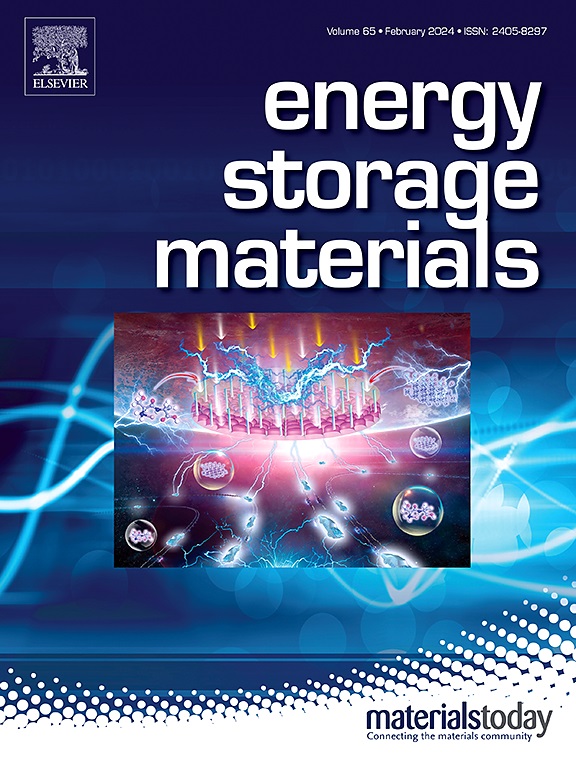Sea cucumber inspired “polymer-in-salt electrolyte” boosting dendrite-free and flexible lithium metal batteries
IF 20.2
1区 材料科学
Q1 CHEMISTRY, PHYSICAL
引用次数: 0
Abstract
The inherent coupling between lithium salt concentration and mechanical robustness, along with inadequate anode compatibility, constrain the practical application of “polymer-in-salt electrolytes” (PISEs). Inspired by biomimetic design principles, a sea cucumber mimetic multifunctional poly(vinyl chloride-co-2-(((2,2,3,3-tetrafluoropropoxy) carbonyl) amino) ethyl acrylate)-based solid polymer electrolyte (PVCTF-SPE) is developed through hydrogen-bond engineering, achieving liquid to solid phase transition via a solvent-free tape casting approach. The introduced multi −NH−···O![]() C− hydrogen-bond interactions decouple the intrinsic trade-off in PISEs, endowing PVCTF-SPE with an ionic conductivity of 1.21 × 10−4 S cm−1, exceptional stretchability (1380 % strain), and autonomous self-healing capability. Furthermore, the superior elastic deformation behavior and strong Li-PVCTF interfacial adhesion effectively mitigate interfacial impedance and suppress tip-induced Li dendrite growth, enabling stable Li deposition/stripping for 3800 h in Li/Li symmetric cells. The strategically engineered molecular structure also delivers an expanded electrochemical window (>4.8 V) and flame-retardant characteristics. A 1.5 Ah Li/LiFePO4 pouch cell demonstrates stable cycling performance (100 cycles, 70 % capacity retention) even under 7.5 % tensile strain and passes rigorous safety tests. This hydrogen bond engineering provides a universal paradigm for developing solid electrolytes with synergistically enhanced ion transport and mechanical stability.
C− hydrogen-bond interactions decouple the intrinsic trade-off in PISEs, endowing PVCTF-SPE with an ionic conductivity of 1.21 × 10−4 S cm−1, exceptional stretchability (1380 % strain), and autonomous self-healing capability. Furthermore, the superior elastic deformation behavior and strong Li-PVCTF interfacial adhesion effectively mitigate interfacial impedance and suppress tip-induced Li dendrite growth, enabling stable Li deposition/stripping for 3800 h in Li/Li symmetric cells. The strategically engineered molecular structure also delivers an expanded electrochemical window (>4.8 V) and flame-retardant characteristics. A 1.5 Ah Li/LiFePO4 pouch cell demonstrates stable cycling performance (100 cycles, 70 % capacity retention) even under 7.5 % tensile strain and passes rigorous safety tests. This hydrogen bond engineering provides a universal paradigm for developing solid electrolytes with synergistically enhanced ion transport and mechanical stability.


海参启发了“盐中聚合物电解质”,促进了无枝晶和柔性锂金属电池的发展
锂盐浓度和机械稳健性之间的固有耦合,以及阳极兼容性不足,限制了“聚合物盐电解质”(PISEs)的实际应用。受仿生设计原理的启发,通过氢键工程开发了一种模拟海参的多功能聚(氯乙烯-co-2-((2,2,3,3-四氟丙氧基)羰基)氨基丙烯酸乙酯)基固体聚合物电解质(PVCTF-SPE),通过无溶剂胶带铸造方法实现了液相到固相的转变。引入的多- NH -···O=C -氢键相互作用消除了PISEs中固有的权衡,使PVCTF-SPE具有1.21 × 10−4 S cm−1的离子电导率,优异的拉伸性(1380%应变)和自主自愈能力。此外,优异的弹性变形性能和强大的Li- pvctf界面附着力有效地减轻了界面阻抗,抑制了尖端诱导的Li枝晶生长,使Li在Li/Li对称电池中稳定沉积/剥离3800 h。这种精心设计的分子结构还提供了扩大的电化学窗口(>4.8 V)和阻燃特性。1.5 Ah Li/LiFePO4袋状电池即使在7.5%拉伸应变下也具有稳定的循环性能(100次循环,70%容量保留),并通过严格的安全测试。这种氢键工程为开发具有协同增强离子传输和机械稳定性的固体电解质提供了一个通用范例。
本文章由计算机程序翻译,如有差异,请以英文原文为准。
求助全文
约1分钟内获得全文
求助全文
来源期刊

Energy Storage Materials
Materials Science-General Materials Science
CiteScore
33.00
自引率
5.90%
发文量
652
审稿时长
27 days
期刊介绍:
Energy Storage Materials is a global interdisciplinary journal dedicated to sharing scientific and technological advancements in materials and devices for advanced energy storage and related energy conversion, such as in metal-O2 batteries. The journal features comprehensive research articles, including full papers and short communications, as well as authoritative feature articles and reviews by leading experts in the field.
Energy Storage Materials covers a wide range of topics, including the synthesis, fabrication, structure, properties, performance, and technological applications of energy storage materials. Additionally, the journal explores strategies, policies, and developments in the field of energy storage materials and devices for sustainable energy.
Published papers are selected based on their scientific and technological significance, their ability to provide valuable new knowledge, and their relevance to the international research community.
 求助内容:
求助内容: 应助结果提醒方式:
应助结果提醒方式:


